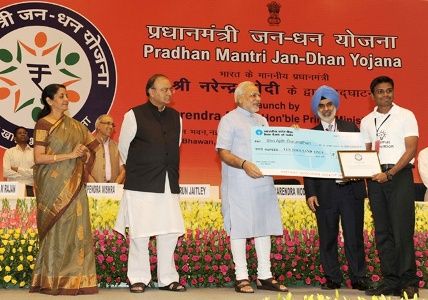 Sometime in August, a rumour went around a small village near Alwar in Rajasthan and in some other parts of the country: “Sarkar jo kala dhan wapas layegi, woh Jan Dhan yojana ke khaato mein baanta jayega”
Sometime in August, a rumour went around a small village near Alwar in Rajasthan and in some other parts of the country: “Sarkar jo kala dhan wapas layegi, woh Jan Dhan yojana ke khaato mein baanta jayega”
(When the government brings back black money, it will be distributed among Jan Dhan accounts).
Among the droves of villagers who had descended upon a State Bank of India branch then, many had fallen for the rumour.
There were other enticements, too -- an in-built accident insurance cover of Rs 100,000, an overdraft facility of Rs 2,000, extendable up to Rs 5,000, and a Rs 30,000 life insurance cover.
Since the project was flagged off on August 28, the account holders make weekly/fortnightly rounds of the branch, often skipping their daily wages.
Their account balance hasn’t moved an inch.
“In the name of financial inclusion, the government has created more problems for the poor,” said the manager of the SBI branch, who did not wish to be identified.
The project is well intentioned and perhaps necessary for a country in which 40 per cent of the population is unbanked.
But, in the hurry to roll out the project, proper communication, especially to the undereducated and the poor, could not happen, said the banker.
After the initial euphoria settled, a significant percentage of people haven’t returned to the branches to do serious transactions.
Less than three months after its launch, the financial inclusion mission has completed its target of opening 75.16 million bank accounts by Tuesday, well ahead of its stated deadline of January 26, 2015.
The finance ministry is going all out in claiming success for the project but, its own data reveals 75 per cent of the accounts or 56.64 million, have no money.
Independent bankers from four separate banks confirmed to Business Standard that people hadopened multiple accounts under the scheme.
This adds to the existing problem of dormant accounts.
The National Council of Applied Economic Research, said out of the 60 per cent households that had access to credit, a large percentage of bank accounts were inactive.
“The lack of use does not necessarily mean a lack of access.
"Some people may have access but (do not) use these services due to various barriers like low income, lack of trust, lack of knowledge, and illiteracy. Others may lack access itself as no financial services are available in their village,” the report said.
A case in point is the scheme, where only 58 per cent of the account holders or 43.3 million people have been provided with the RuPay debit card so far.
For safety reasons, the cards have to be collected from the branches but the uptake has been slow.
The debit card personal identification numbers of the cards collected are being dispatched by post but a significant percentage are being returned for lack of proper addresses.
Banks find it does not make economic sense for them to operate these accounts.
The banking sector has garnered Rs 5,903 crore (Rs 59.03 billion) since the scheme was launched. However, banks had to incur a basic minimum cost of at least Rs 200 on opening each account, if not more.
This went into issuing a passbook, a RuPay card, mailing the PIN, etc, apart from the manpower cost of dealing with customers.
This totals roughly Rs 1,500 crore (Rs 15 billion) in cost for banks in just opening the accounts.
“We have opened 500 accounts on a weekly basis, but if I look at the cumulative deposits of my branch, this has not even increased by Rs 100,000,” said the SBI bank manager.
A Punjab National bank official said the government was expecting banks to further the agenda of financial inclusion, but not offering them any incentive to do so. “You can’t keep milking the banking system,” he said.
The government had given about 20 million RuPay debit cards before the launch of Jan Dhan. Not many people are aware that the accident cover of Rs 100,000 was always given with the card and not introduced specifically under the scheme.
Also, in 2013-14, the United Progressive Alliance government had added 60.9 million accounts.
Bankers argue that after some lag, if the inoperational or fake accounts are weeded out, the actual figure are likely to be around the same number -- with only a slight increase.
The PNB official said the bank had planned the implementation of the scheme over a year, which included setting up a banking correspondent network, creating financial literacy, doing household surveys, etc.
But, the pressure from the Centre made them abandon all pre-launch preparations.
Experts argue the Modi administration had to set almost impossible targets because the banks had been dragging their feet, despite many directives from the Reserve Bank of India and the previous regimes.
Aman Agarwal, professor at the Indian Institute of Finance, said the intent of the scheme was to bring substantial savings from unbanked regions of the country into the banking net.
However, he agrees the supporting infrastructure might not be present in rural areas to facilitate banking.
“Perhaps mobilising the Post Office network is the best solution, he said.”
Abhijit Lele and M Saraswathy from Mumbai, and Vrishti Beniwal from New Delhi contributed to the story










